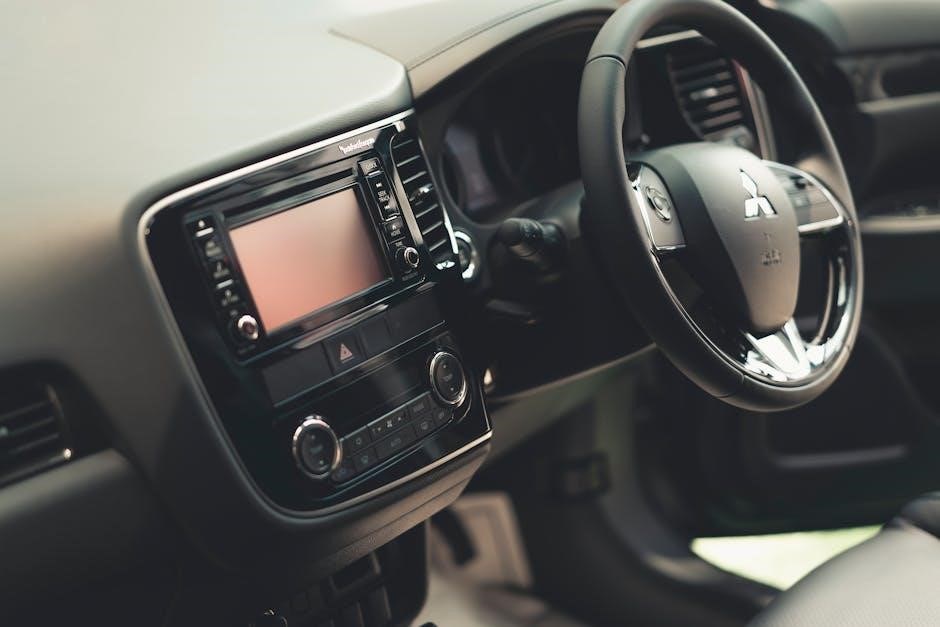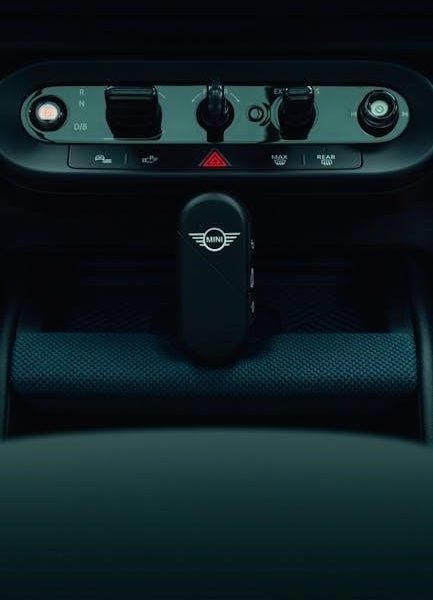The Mitsubishi Mini Split Manual provides essential information for installing‚ operating‚ and maintaining your ductless system. It ensures safe and efficient setup‚ covering key features and troubleshooting tips.
Overview of the Mitsubishi Mini Split System
The Mitsubishi Mini Split System is a ductless heating and cooling solution designed for energy efficiency and flexibility. It consists of an indoor unit and an outdoor unit connected by refrigerant lines. This system is ideal for spaces where traditional ductwork is impractical or unnecessary. The inverter-driven compressor ensures precise temperature control and reduced energy consumption. Available in various models‚ it offers both cooling and heating modes‚ making it suitable for year-round use. The compact design allows for discrete installation‚ preserving interior aesthetics. With advanced features like silent operation and programmable controls‚ it provides comfort and convenience. Proper installation‚ as outlined in the manual‚ is crucial for optimal performance and safety. This system is a popular choice for modern‚ efficient climate control in residential and commercial settings.
Importance of the Installation Manual
The Mitsubishi Mini Split Manual is a comprehensive guide essential for proper system installation‚ operation‚ and maintenance. It provides detailed instructions to ensure safety‚ efficiency‚ and compliance with standards. The manual covers installation requirements‚ tool lists‚ and step-by-step procedures‚ preventing potential hazards like fire or electric shock. It also outlines safety precautions and troubleshooting tips‚ helping users address common issues. By following the manual‚ installers can avoid costly mistakes and ensure optimal system performance. This document is indispensable for both professionals and DIY enthusiasts‚ guaranteeing a smooth setup and long-term reliability of the Mitsubishi Mini Split System. Always refer to the manual before starting any installation or maintenance work to achieve the best results.

Key Features of Mitsubishi Mini Split Systems
Mitsubishi Mini Split Systems are known for their advanced features‚ including high-efficiency inverter technology‚ which optimizes energy use and reduces operational noise. These systems offer both cooling and heating modes‚ making them versatile for year-round use. The ductless design allows for flexible installation options‚ preserving interior aesthetics. Remote control functionality provides easy operation‚ while smart sensors adjust settings based on room conditions. Additional features include advanced filtration systems‚ improving indoor air quality‚ and energy-saving modes to minimize consumption. Many models also support Wi-Fi connectivity for smart home integration. These systems are designed for reliability‚ with features like leak detection and auto-restart capabilities. Overall‚ Mitsubishi Mini Split Systems combine innovation‚ efficiency‚ and convenience‚ making them a popular choice for modern heating and cooling needs.

Installation Requirements
Ensure proper location‚ level surface‚ and electrical connections. Follow manual guidelines for power supply‚ drainage‚ and refrigerant handling to ensure safe and efficient system setup.
Pre-Installation Checks
Before starting the installation‚ ensure the site is prepared and all necessary tools are available. Check for any damage to the units and verify the refrigerant charge. Ensure proper drainage and electrical connections‚ and confirm the system’s compatibility with the space. Inspect the area for obstructions and ensure the outdoor unit is placed on a sturdy‚ elevated base. Verify that all local building codes and safety regulations are met. Review the manual to understand specific requirements for your model. Ensure the power supply matches the system’s specifications‚ and all pipes and wires are correctly sized. Perform a final check to confirm all components are included and undamaged before proceeding with the installation.
Required Tools and Materials
To ensure a smooth installation‚ gather all necessary tools and materials beforehand. Essential tools include a drill set‚ wrenches‚ screwdrivers‚ and a vacuum pump for refrigerant lines. You’ll also need materials like copper pipes‚ insulation‚ and electrical wiring. A manifold gauge is required for checking refrigerant pressure. Ensure you have a tubing cutter for precise pipe cutting and a deburring tool to smooth pipe edges. Proper insulation materials are crucial to prevent energy loss. Safety gear‚ such as gloves and goggles‚ should always be on hand. Refer to the manual for specific tool recommendations tailored to your Mitsubishi model. Having all items ready ensures compliance with safety standards and manufacturer guidelines‚ preventing potential issues during installation.
Step-by-Step Installation Process
Start by preparing the installation site‚ ensuring it is clear of debris and obstacles. Mount the indoor unit securely on a sturdy wall or ceiling‚ following the manual’s guidelines for alignment and spacing. Next‚ position the outdoor unit on a level surface‚ ensuring proper drainage and airflow. Connect the refrigerant lines‚ electrical wires‚ and drainage tubing between the indoor and outdoor units. Tighten all connections carefully to avoid leaks. Power on the system and perform a test run to check for proper operation. Finally‚ inspect all connections and ensure the system functions efficiently. Always refer to the manual for specific instructions and safety precautions to guarantee a successful installation.
Connecting Indoor and Outdoor Units

Connecting the indoor and outdoor units of your Mitsubishi mini split system requires careful planning and execution. Begin by ensuring both units are properly installed and aligned according to the manual’s specifications. Locate the connection points for the refrigerant lines‚ electrical wires‚ and drainage tubing. Insulate the refrigerant lines to prevent energy loss and ensure they are securely connected to both units. Use a vacuum pump to remove air and moisture before charging with refrigerant. For electrical connections‚ follow the wiring diagram in the manual‚ using the correct gauge wire and ensuring all connections are tight. Connect the drainage system‚ sloping the drain line to prevent backups. After completing all connections‚ test the system for leaks and proper operation. Refer to the manual for specific instructions and safety precautions to ensure a successful setup.
Post-Installation Checks
After completing the installation‚ perform a series of post-installation checks to ensure the system operates safely and efficiently. First‚ verify that all electrical connections are secure and meet the manual’s specifications. Check the refrigerant lines for leaks using a vacuum pump and ensure proper insulation. Inspect the drainage system to confirm it is functioning correctly and sloped to prevent water accumulation. Test the system by running it in both cooling and heating modes to ensure proper operation. Check for any unusual noises or vibrations. Finally‚ review the installation with the user‚ explaining safety precautions‚ maintenance routines‚ and system controls. Always refer to the Mitsubishi Mini Split Manual for detailed procedures to ensure optimal performance and compliance with safety standards.
Safety Precautions
Always follow the Mitsubishi Mini Split Manual guidelines to ensure safe installation and operation. Avoid improper electrical connections and refrigerant handling to prevent hazards. Ensure proper grounding and ventilation.
General Safety Guidelines
Adhering to general safety guidelines is crucial when handling Mitsubishi Mini Split systems. Always follow the instructions outlined in the installation manual to avoid accidents. Ensure proper grounding of electrical components to prevent shock hazards. Never attempt installation without proper training‚ as incomplete work can lead to fire risks or system malfunctions. Keep the area clear of flammable materials during setup. Use only authorized tools and materials specified in the manual to maintain safety standards. Ensure adequate ventilation in the room where the unit is installed to prevent gas leaks or refrigerant exposure. Regularly inspect the system for signs of wear or damage‚ and address issues promptly. Always disconnect power before performing maintenance or repairs. By following these guidelines‚ you can ensure a safe and efficient operating environment for your Mitsubishi Mini Split system.
Handling Refrigerants Safely
Handling refrigerants safely is critical to prevent environmental damage and personal injury. Always wear protective gear‚ including gloves and safety glasses‚ when handling refrigerant lines or components. Ensure all connections are secure to avoid leaks‚ which can harm the environment and reduce system efficiency. Use only approved tools and follow proper procedures when charging or recovering refrigerant. Never mix different refrigerant types‚ as this can cause system malfunctions. Keep the work area well-ventilated to prevent inhalation of refrigerant vapors. Dispose of refrigerant waste responsibly‚ adhering to local regulations. Refer to the Mitsubishi Mini Split Manual for detailed guidelines on safe refrigerant handling. Proper care ensures system reliability and environmental protection. Always follow safety protocols to minimize risks associated with refrigerant handling.
Electrical Safety Measures
Electrical safety measures are essential to ensure safe installation and operation of your Mitsubishi Mini Split system. Always use a dedicated circuit for the unit‚ avoiding the use of extension cords or multiple devices on one outlet. Ensure all electrical connections are secure and meet local wiring standards. Before servicing‚ turn off the power supply at the circuit breaker. Never attempt to modify or bypass safety features. Use only approved electrical components and follow the Mitsubishi Mini Split Manual guidelines. Proper grounding of the system is crucial to prevent electrical shocks. If unsure‚ consult a licensed electrician. Regularly inspect wires and connections for damage or wear. Adhering to these measures ensures safe operation and prevents potential hazards. Always prioritize electrical safety to protect both the system and its users.

System Components
The Mitsubishi Mini Split system consists of indoor and outdoor units‚ connected by refrigerant lines. The indoor unit includes a fan‚ evaporator‚ and controls‚ while the outdoor unit houses the compressor and condenser. Additional components include the refrigerant‚ drainage system‚ and remote control for operation. These parts work together to provide efficient heating and cooling‚ ensuring optimal performance and comfort.
Indoor Unit Components
The Mitsubishi Mini Split indoor unit includes a fan coil‚ evaporator‚ and advanced controls. The fan ensures quiet air circulation‚ while the evaporator absorbs heat for cooling or releases it for heating. The unit also features air filters to improve indoor air quality and a drainage system to manage condensation. Controls like the wireless remote or wall-mounted interface allow users to adjust settings. Additionally‚ the indoor unit includes sensors to monitor temperature and operation‚ ensuring efficient performance. Proper maintenance of these components‚ as outlined in the manual‚ is crucial for optimal system functionality and longevity.
Outdoor Unit Components
The Mitsubishi Mini Split outdoor unit houses the compressor‚ condenser coil‚ and fan‚ which are essential for heat exchange and refrigerant circulation. The compressor compresses the refrigerant‚ while the condenser coil dissipates heat to the surrounding air. A protective grille covers these components to prevent damage. The unit also includes refrigerant tubing and electrical connections that link it to the indoor unit. Proper installation and leveling of the outdoor unit are critical for efficient operation‚ as outlined in the manual. Regular maintenance‚ such as cleaning the condenser coil‚ ensures optimal performance. The outdoor unit is designed to withstand various weather conditions and includes features to protect against extreme temperatures and moisture.

Refrigerant and Drainage System
The Mitsubishi Mini Split system uses R-410A refrigerant for efficient heat transfer. The refrigerant flows between the indoor and outdoor units‚ facilitated by insulated copper tubing. Proper handling and installation are crucial to prevent leaks‚ which can reduce system performance and pose environmental risks. The drainage system ensures condensate water from the indoor unit is discharged safely. Regular checks of the drain hose and pan are essential to prevent blockages and water damage. The manual emphasizes secure connections and adherence to safety guidelines during installation to maintain system integrity and efficiency. Proper maintenance of these systems ensures reliable operation and extends the lifespan of the unit.

Operating Instructions
Learn how to operate your Mitsubishi Mini Split system effectively. The manual guides you through starting the system‚ using the remote control‚ and understanding error codes for smooth operation.
Starting the System
To start the Mitsubishi Mini Split system‚ ensure all electrical connections are secure and the remote control is functional. Turn on the power at the outdoor unit and the circuit breaker. Press the ON/OFF button on the remote to initiate operation. The indoor fan will begin at High speed and automatically adjust based on the set temperature; After 30 minutes‚ the system enters EMERGENCY COOL/HEAT MODE‚ setting the temperature to 75°F (24°C) and reducing fan speed to Med. This mode ensures continuous operation while protecting the system. Always refer to the manual for specific startup procedures and safety guidelines to ensure optimal performance and efficiency.
Using the Remote Control
The remote control is the primary interface for operating your Mitsubishi Mini Split system. Press the ON/OFF button to power the unit on or off. Use the MODE button to select between cooling‚ heating‚ or fan-only operation. Adjust the temperature using the TEMP up and down arrow buttons. The FAN SPEED button allows you to choose between low‚ medium‚ or high fan settings. For advanced features‚ press the TIMER button to set on/off schedules. The remote also displays the current temperature and operating mode on its LED screen. Always ensure the remote has fresh batteries for optimal performance. Refer to the manual for detailed instructions on using additional features like swing mode or energy-saving settings to maximize comfort and efficiency.
Understanding Error Codes
Mitsubishi Mini Split systems display error codes to help diagnose issues quickly. These codes‚ such as E1‚ E2‚ or E3‚ indicate specific problems like sensor malfunctions or refrigerant leaks. Refer to the manual for a full list of codes and their meanings. Each code corresponds to a particular fault‚ guiding you or a technician to the root cause. For example‚ an E1 code often points to a communication error between the indoor and outdoor units. Understanding these codes ensures timely repairs and prevents further damage. Always consult the manual or contact a professional if you encounter persistent issues. Regular checks and proper maintenance can reduce the likelihood of errors‚ ensuring your system runs efficiently and effectively year-round.
Switching Between Cooling and Heating Modes
To switch between cooling and heating modes on your Mitsubishi Mini Split‚ use the remote control. Press the Mode button until the desired mode is selected. The remote display will show icons indicating the current mode: a snowflake for cooling and a sun for heating. Once selected‚ adjust the temperature using the up or down arrows. Ensure the system is set to the correct mode for seasonal operation to optimize performance and energy efficiency. For added convenience‚ use the timer function to schedule mode changes. Always refer to the manual for specific instructions‚ as controls may vary slightly by model. Proper mode selection ensures your system operates effectively‚ providing consistent comfort year-round. Regular maintenance‚ like cleaning filters‚ also supports smooth mode transitions.

Maintenance and Care
Regularly clean air filters and check for refrigerant leaks to ensure optimal performance. Schedule professional servicing annually and refer to the manual for specific care instructions.
Cleaning the Air Filters
Regular cleaning of the air filters is essential for maintaining optimal performance and energy efficiency. Turn off the power supply before removing the filters.
Gently vacuum or wipe the filters with a soft‚ dry cloth to remove dust and debris. Avoid using harsh chemicals or water‚ as this may damage the filters.
Inspect the filters for tears or excessive wear. If damaged‚ replace them immediately to ensure proper airflow and system operation.
Clean the filters every 1-2 months‚ depending on usage‚ to prevent dust buildup and maintain indoor air quality.
Refer to the manual for specific cleaning instructions and recommendations for your Mitsubishi Mini Split model.
Maintaining the Condenser Coils
Regular maintenance of the condenser coils is crucial for ensuring efficient heat transfer and system performance. Turn off the power supply before starting any cleaning.
Gently remove any debris‚ such as leaves or dirt‚ from the coils using a soft brush or garden hose on a low setting. Avoid using harsh chemicals or abrasive materials.
Inspect the coils for bent fins and straighten them carefully with a fin comb to maintain proper airflow. Clean the condenser coils every 2-3 months or as needed.
Ensure the outdoor unit is elevated and has adequate drainage to prevent water accumulation‚ which can lead to corrosion or reduced efficiency.
Refer to the Mitsubishi Mini Split manual for detailed instructions and guidelines specific to your model.
Drainage System Maintenance
Regular maintenance of the drainage system is essential to prevent water accumulation and ensure proper operation. Inspect the drainpipe for blockages‚ such as dirt or debris‚ and clean it as needed.
Ensure the drainpipe is securely connected to both the indoor and outdoor units to avoid leaks. Check for any signs of water pooling or damage around the system.
If you notice water leakage‚ turn off the system immediately and consult a professional. Clean the drainage system every 1-2 months‚ especially in high-humidity areas.
Refer to the Mitsubishi Mini Split manual for specific instructions on drainage system care and troubleshooting common issues like clogs or improper drainage.
Scheduling Professional Servicing
Regular professional servicing is crucial to maintain the efficiency and longevity of your Mitsubishi Mini Split system. Schedule annual maintenance with a certified HVAC technician to ensure optimal performance.
During servicing‚ professionals will inspect and clean components‚ check refrigerant levels‚ and verify electrical connections. This helps prevent issues like refrigerant leaks or system malfunctions.
Additionally‚ have your system serviced before extreme weather seasons to ensure reliability. Refer to the manual for recommended maintenance intervals and guidelines.
Always rely on authorized Mitsubishi service providers to guarantee compliance with manufacturer standards and warranty terms. Proper servicing ensures your system operates safely and efficiently year-round.

Troubleshooting Common Issues
Identify and resolve issues quickly using the manual’s troubleshooting guide. Address error codes‚ refrigerant leaks‚ and drainage problems promptly to maintain efficiency and prevent system damage.
Refrigerant Leaks
Refrigerant leaks are a common issue that can significantly reduce system efficiency. Always check for leaks after installation and during maintenance. Use a leak detector or soap solution to identify escaping refrigerant. Ensure all connections are tight and properly sealed. Refer to the manual for specific instructions on handling refrigerant safely. If a leak is detected‚ turn off the system immediately and consult a professional. Prolonged leaks can cause environmental harm and reduce cooling performance. Regular inspections and proper handling of refrigerant lines are crucial to prevent such issues. Follow the guidelines in the manual for safe and effective leak repair procedures.
Drainage Problems
Drainage issues can lead to water accumulation‚ causing damage and mold growth. Ensure the condensate drain is clear and properly sloped. Regularly inspect the drain line for blockages or kinks. If water leaks from the indoor unit‚ check the drain pan and piping connections. Refer to the manual for drainage system maintenance. Use a level tool to ensure the unit is installed correctly‚ allowing proper water flow. Clean the drain pan and filters regularly to prevent clogs. If issues persist‚ consult a professional to avoid system damage. Proper drainage is essential for efficient operation and preventing water-related problems.
Sensor Malfunctions

Sensor malfunctions can disrupt system performance‚ causing inaccurate temperature readings or operational issues. Check for dirt or debris on sensors‚ as this can interfere with their function. Ensure all connections are secure and free from damage. If the system displays error codes related to sensors‚ refer to the manual for troubleshooting steps. Cleaning or replacing faulty sensors may resolve the issue. If the problem persists‚ reset the system or consult a professional. Regular maintenance‚ like cleaning filters‚ can prevent sensor malfunctions. Always follow the manual’s guidelines for handling and testing sensors to ensure accurate system operation and avoid further complications.
Power Supply Issues
Power supply issues can cause the Mitsubishi Mini Split system to malfunction or fail to turn on. Check the circuit breaker or fuse box to ensure the unit has a stable power supply. Verify that the power cord is securely connected to both the unit and the electrical outlet. Avoid using extension cords or shared circuits‚ as this can lead to voltage fluctuations. If the issue persists‚ inspect the wiring for damage or loose connections. Consult a licensed electrician if you suspect a problem with your home’s electrical system. Regularly inspect the power cord and connections to prevent future issues. Always follow the manual’s guidelines for electrical safety and troubleshooting to restore proper function and ensure system efficiency.
The Mitsubishi Mini Split Manual ensures optimal performance and safety. For further assistance‚ visit Mitsubishi’s official website or contact their customer support for detailed resources and updates.
Final Checks and System Optimization
After completing the installation‚ perform final checks to ensure the system operates efficiently. Verify that all electrical connections are secure and the refrigerant lines are tightly sealed to prevent leaks; Check the drainage system for proper water flow and ensure the outdoor unit is level. Test the system in both cooling and heating modes to confirm optimal performance. Additionally‚ inspect the air filters and ensure they are clean for unobstructed airflow. Adjust the system settings according to your preferences for maximum comfort and energy efficiency. Refer to the manual for specific optimization instructions tailored to your Mitsubishi model. Finally‚ schedule a professional servicing to ensure long-term reliability and performance. Proper final checks ensure your mini-split system runs smoothly and maintains energy efficiency throughout its lifespan.
Accessing the Mitsubishi Mini Split Manual Online
To access the Mitsubishi Mini Split Manual online‚ visit the official Mitsubishi Electric website or authorized retailers like Home Depot. Navigate to the “Support” or “Resources” section and search by model number. The manual is typically available in PDF format for easy download. For specific models‚ such as the MSZ-FE18NA or MSZ-GE12NA‚ visit websites like ManualsLib or ManualsOnline‚ which host a wide range of Mitsubishi manuals. Ensure you download the correct version for your system to access accurate installation‚ operation‚ and maintenance instructions. This ensures safe and efficient use of your Mitsubishi Mini Split system. Always refer to the official sources to avoid outdated or incorrect information.
